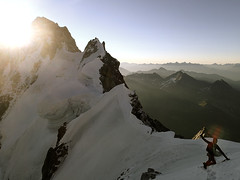Sea stacks are often special or even dream objectives for rock climbers.
The sharp spire soaring directly from roaring sea offers a great adventure.
Why?
First, the original and archtypal goal of climbing is to go high, perhaps up to the (locally)
highest point, and preferably somewhere unreachable without climbing.
In the UK, Napes Needle in the Lake District is the first recorded climbing
in that respect, that is, climbing for the sake of it, rather than
a means of training for bigger objectives like Himalaya.
Sea stacks are of course an ideal objective, being independent
and eye-catchingly distinctive.
Second, sea cliffs usually add a dimension of excitement and often risk
(or challenge) and difficulty to deal with in climbing, such as the tide.
To climb above (possibly) crashing waves feels certainly exciting!
Unlike most sea-cliff climbing, to top out to complete an ascent is
not the end of the game. You will have to descend, usually by abseiling,
and then perhaps to negotiate the sea and/or tide to get back to safety.
Third, most sea stacks are off the beaten track. Climbers can enjoy
the solitude, as well as the excitement due to its commitment.
Not to mention, those pros serve at the same time as cons, or added risks.
Sea stacks were formed as a stack with a good reason, that is,
the rocks are not the most solid, even exacerbated by the harsh coastal climate.
Famously, a British climber Paul Pritchard has suffered a serious injury
due to a rock fall during his attempt of climbing
The Totem Pole in Tasmania,
which left him in haemiplegia.
The challenge to climb a sea stack should not be underestimated.
As a mountaineer, I love climbing peaks and pinnacles that are unreachable
without climbing. In Peak District, where I learnt trad climbing,
Rivelin Pinnacle was one of the big objectives in my early climbing career.
In the Lake District, High Man in Pillar Rocks, which is technically the only mountain
in England inaccessible without climbing, was once very high in my wish list.
So was Inaccessible Pinnacle in Isle of Skye. Terrier's Tooth in Chair Ladder,
Cornwall, which finishes at the top of a little pinnacle,
was good to climb for the same reason, albeit the pinnacle is
not very significant.
Then sea stacks naturally draw my attention. However, I have climbed only one stack
so far — The Souter in Scottish Border. It was good, and better than
Rivelin Needle, Terrier's Tooth and alike. Nevertheless, I know
it is nowhere close to the best that Britain, or practically Scotland, can offer.
There are many sea stacks in the coast in Scotland; among those,
the so-called Big Three are, Old Man of Hoy in Orkney,
an Old Man of Stoer and Am Buachaille in the far north-west Highlands.
They are the biggest major sea stacks in British Isles, with Hoy being the tallest at 137m (n.b., see the note in the main article).
The fact all of them are remote from major areas in Britain means
the logistics are not easy for most people, including most Scots, let alone
those from the south. The Scottish weather is anyway not renowned
for being mild or dry to say the least, and the north-west coast tends to
be the worst in Scotland. That means even if one makes
everything else in the logistics right, it is fairly common they are
turned down by the weather. As such, the level of commitment and effort is high
in the Scottish sea-stack climbing. But the reward must be all the higher,
if one suceeds.
The southerner Michelle has never climbed any sea stacks before,
and decided to come up north to attack sea stacks for a week in September
with me. The plan is hopefully to climb the Big Three or a part of them,
depending on the weather and our progress, all via the standard (easiest) routes.
Most pitches being VS or below, which is
within Michelle's leading grade, she would lead some pitches or maybe alternate
leads. But if things get tough or serious, I would take the lead.
Just 10 days before the week, I had taken a seriously bad fall,
which put me on bed for a couple of days. Fortunately, I have recovered
just enough to make it in time, with or hopefully without pain killers.
So began the game.












